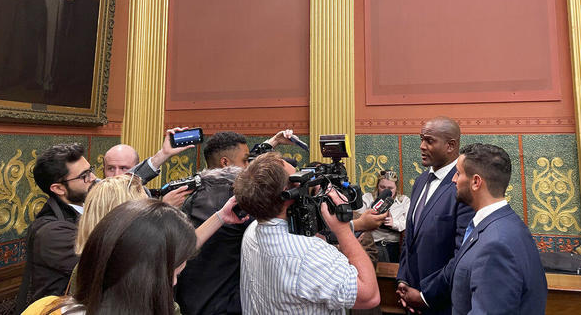Democrats Fail to Flip Legislatures, but Republicans Take Back New Hampshire
Despite winning the presidency, Democrats largely failed last week in their goal of increasing their control of statehouses across the nation.
Democrats went into last Tuesday’s election thinking they had a chance to flip Republican Senate majorities in Alaska, Arizona and Minnesota and to pick off Republican House or Assembly majorities in Alaska, Arizona, Iowa, Michigan North Carolina, Pennsylvania and Texas. They appear, however, to have lost every race.
The Arizona Senate contest remains tight, but Republicans on Friday claimed to have held both chambers, despite Joe Biden’s strong showing and possible victory there in the presidential race.
Alaska’s returns remain inconclusive, but Democrats’ hopes there too have dimmed. The Alaska House had a 23-16 Republican majority going into the election, but defections had given control of the chamber to a coalition made up mostly of Democrats.

Republicans, meanwhile, entered the election season with realistic hopes of flipping only the New Hampshire House and Senate. They succeeded in winning control of both chambers.
The near-rout again leaves Republicans with an upper hand in redrawing congressional and state legislative districts after the 2020 census. Republican legislatures in 2010 were able to draw 55% of all congressional districts, while Democrats drew only 10%. After last week’s election, an analysis by Fivethirtyeight.com forecast that 117 congressional districts (27% of the House) now will likely be drawn by Republicans, while only 47 (11%) to be drawn by Democrats. The remaining 132 districts (30%) will be drawn by independent commissions or through a bipartisan process.
The Republican’s big victory in New Hampshire reverses the results of the 2018 election, when the Democrats seized control of both houses. The New Hampshire legislature is particularly volatile, especially the 400-member House of Representatives, most of whose members are elected from multi-member districts that simultaneously elect as many as 11 representatives. 2020 now marks the sixth time the House has changed hands since 2004, while the Senate has now turned over four times.
The turnabout in New Hampshire gives Gov. Chris Sununu a Republican trifecta – an oddity in a state whose four-member congressional delegation – three of whom just won re-election – are all Democrats.

Gov. Chris Sununu
Republicans even flipped the five-member Executive Council, an anachronistic vestige of colonial times that continues to play a major policy role in New Hampshire. Democrats went into the election with a 3-2 advantage there, but emerged on the wrong side of a 4-1 split. The result of all these changes is that Democrats will mostly be watching from the sidelines for the next two years as Sununu and his Republican allies advance their political agenda.
In New Hampshire and elsewhere, Democrats blamed many of their setbacks this year on 10-year-old districts that do not reflect population shifts over the past decade. In Minnesota, for example, Rep. Frank Hornstein’s fast-growing Minneapolis district now has more than 35,000 registered voters, while Rep. Deb Kiel’s district in rural Crookston has only 22,000. Another factor: many of the districts themselves were drawn ten years ago by Republicans, to their advantage.
But high turnout was also a factor. Although Democrats again drew record numbers to the polls, many more Republican voters too turned out this year in support of President Trump.
Rising rates of coronavirus infections also kept Democrats in particular from engaging in in-person events, such as in campaigning door-to-door.
Still, many Democratic legislative candidates across the country underperformed standard-bearer Joe Biden. Had that not happened, the Republicans, for example, would have lost the Minnesota Senate,
Even in many states with lopsided partisan majorities, Democrats were licking their wounds as Tuesday’s results became clear.
In New York, Democrats had reason to believe they could win a Senate supermajority, going into the election with a 40-20 edge, with vacancies in 3 seats. Instead they trailed in several races pending the counting of the remaining absentee ballots.
House Democrats in Oregon hoped to grow their supermajority to prevent members of the minority from disappearing and denying them a quorum, as happened this year. Instead, they suffered a net loss of one seat.
Democrats needed only one more seat to break the Republican supermajority in the Kansas House, but lost two seats instead. This leaves the Republican House in a position to override vetoes by Democratic Gov. Laura Kelly.
In some heavily Democratic states, Democrats did make headway. Connecticut, for example, saw Democrats capture two more seats in the Senate and at least seven in the House. Massachusetts Republicans, who hold only four seats in the 40-member Senate, lost one in last week’s election, leaving them with a historically small three-member delegation in 2021.
Democrats also appear to have prevented Republicans from obtaining a filibuster-proof majority in the Nebraska Senate. Nebraska, the only state with a unicameral legislature, has no House of Representatives, and its Senate is officially nonpartisan.
In Washington, Democrats seem poised to grow their legislative majorities slightly. Following nonpartisan primaries, some of the races there pitted two Democrats against each other, creating a situation that appears to be pulling their legislative majority to the left.
In Michigan, some Republicans candidates were reportedly following the lead of U.S. Senate candidate John James in refusing to concede races they had apparently lost.
Democrats also failed to pick up the two governors’ races that seemed to be within their grasp. Incumbent Republican Gov. Mike Parson turned away a Democratic challenge in Missouri, while Republican U.S. Rep. Greg Gianforte was elected governor of Montana, succeeding Democratic Gov. Steve Bullock.


